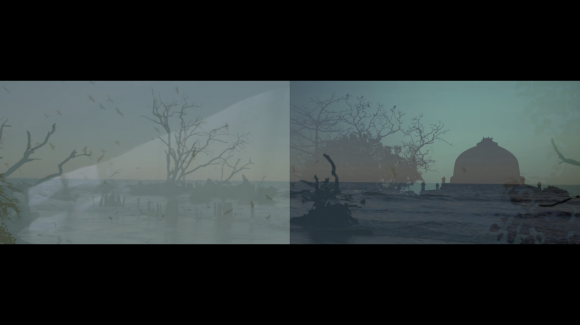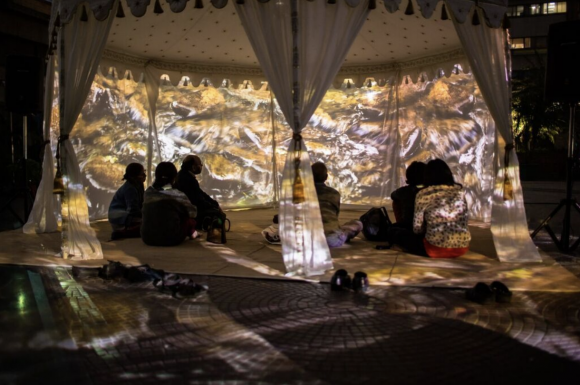“When I was doing grassroots work… around specific issues associated with trauma state violence sexual violence. I found that I wasn’t offering enough just documenting it. Witnessing is very important but then what do we do with all that pain, where do we take it? …many of us not from the “first world”, are coming from traditions where there is a conscious appreciation of healing, for taking something beyond intellect and so that’s always operating in my mind when I’m doing a piece. am creating a space for catharsis, a space for transformation, where we can maybe push the conversation in a different direction.”
Sheba Remy Kharbanda is a New York based British video artist, filmmaker and researcher whose work explores subjects of migration and displacement in the Indian diaspora. Her work harnesses the full power of the video medium employing it not only spatially and visually but also documents oral histories that go untold. Kharbanda’s creative practice is fostered by her work as a qualitative researcher for human rights organisations such as Amnesty International, Human Rights Watch and the Urban Justice Center. She is also the co-founder of RFR, a research collaborative that works with community-based organizations to facilitate and support popular education and organizing efforts. Kharbanda work has been installed and show internationally at like The Invisible Dog in Brooklyn, the Caos Art Gallery in Venice, Italy, the Southbank Centre in London and the India Habitat Centre in New Delhi, India. Additionally, Kharbanda operates a spiritual practice and offers sessions in Astrology, Tarot and Energy work.
___________________________________________________________________________
Donalea Scott: Can you tell me a little about your practice and how you came to it?
Sheba Remy : I don’t really like practice because it makes it seem like it’s a separate thing. It was a kind of esoteric, spiritual thing that brought me to making video art. It wasn’t any kind of intellectual decision where I just said oh I’m just going to do it this way. It had more to do with the way my brain works and the limits of being able to communicate within the written word.
DS: Ok, so how did you come to work with video art?
SRK: I didn’t go to art school. I have a theory background. I used to be and still occasionally do legal and policy research for grassroots organisations collecting qualitative research. At the same time I was working in video and film but just as a way to pay my bills, it weren’t for the love of it. I’ve definitely grown to love it because it is the best tool that I have to convey how I see the world and how I would like to see the world and I marry that film making. I have a video production company and I do all kinds of stuff for other people with my vision.




SRK: It was just a way to make money because I wasn’t when I was a legal researcher and for reasons that are not linear I’ve been involved in video production in different ways since university. When I moved here I start working for NGO’s doing their public policy research at grassroots level. Funding was a huge problem and video production was kind of the next thing I could fall back on. I had connections, I had the know-how and it’s been, I guess you could say, a crutch that I fell into very haphazardly.
DS: So what is it about the medium that compels you to work with it?
SRK: I video and film to be a very powerful medium. The visual medium has a different language then the written language. was able to reach people but also able to, I guess you could say, expand the space in the visual field who we usually get to see in visuals and who we don’t.
DS: What are you trying to achieve with your art, what is your aim?
SRK: I guess in a real world context what I’m trying to achieve is to wedge and create more space for the kind of narratives I work with, which is very non-linear, and through creating more space create more appreciation for it. I find there is a big cultural disconnect between where I’m coming from literally but also metaphysically. This cultural context tends to be attached to certain kinds of narrative, certain liner storytelling styles that don’t appeal to me, I don’t connect to those and so I would say that I’m trying to assert a different style, voice, and vision that’s not represented in the mainstream here.
DS: In awareness of your resistance to describing what you do as a “practice”, I wonder then what “working” means for you?
SRK: A lot of its contemplative, a lot of it is just sitting with a feeling more than a thought. It’s motivated by a sense of displacement. My work, at its crux, is about displacement. It often involves sitting and contemplating and then asking myself questions about how do I want to touch on that feeling, how do I want to convey it? There is a superficial level of reacting to my feelings and then there’s that deeper thread and so I’ll kind of do digging and the digging is kind of psycho-spiritual-emotional dig for what’s really going on here, what do I really want to say. I’ll often read or look at work by other people who are touching on similar issues and then I wait. There is a lot of waiting around to my body of work because the acting and starting of physical material work from that place of readiness, of feeling like ok now I’m ready to do it in this way. The images can come from an image I see, a dream, something I’ve read, something someone has said to me and then I just I’ll know that this is how I want to communicate this.
DS: And what do you believe is essential in communicating with an audience?
SRK: You know video art is in its infancy and it’s a bit avant-garde. Avant-garde doesn’t have to mean elitist but it’s come to mean elitist. I appreciate consuming video art and I seek it out I find that the kinds of people who are doing the same I don’t connect with, I don’t relate with philosophically and I don’t relate with them culturally. So I feel like a piece has been successful when it can reach people who are not otherwise reached to this medium. I can open people’s eyes to what the possibilities are, the potential are for these kinds of non-linear narratives.
DS: How do you know when what you are doing has worked?
SRK: I can show a piece and that’s great but I don’t have feedback from people who might not otherwise go and see something like that then I’m not really convinced that it’s been successful.
DS: Is it possible to think about this accidental audience when you create a piece?
SRK: Yeah, I would say there is always that consideration. The difference between art and a hobby is that you want people to experience it, you want them to consume it −even if there is not a transaction involved− you want them to be exposed to it, you want them to have a reaction, you want them to engage with it on some level. But that’s not the primary motivator. The primary motivator is conveying a vision and giving voice to something that’s usually not given a voice too typically.
DS: Do you think you know your audience?
SRK: If I was going to classify or group an audience I would say its people who are not in the mainstream. And that cuts across identities. People who don’t identify with the mainstream, who may not even think they like art but can appreciate different voice and vision.
DS: And what kind of change are you wanting this to bring about in the world?
SRK: When I was doing grassroots work the same themes would come up over and over again, I was doing work around specific issues associated with trauma state violence sexual violence. I found that I wasn’t offering enough just documenting it. Witnessing is very important but then what do we do with all that pain, where do we take it? This culture is very good about intellectually recognising something but then where the rest of us are coming from, you know, many of us not from the “first world”, are coming from traditions where there is a conscious appreciation of healing, for taking something beyond intellect and so that’s always operating in my mind when I’m doing a piece. am creating a space for catharsis, a space for transformation where we can maybe push the conversation in a different direction. And how do I know that’s happened or how do I know that that’s what I’m doing? For me it’s about intention. Like if I go into doing a piece then that’s my intention and I feel like it intends to work that way.
DS: In terms of creating this catharsis space, are you getting confirmation from your audience that this occurring?
SRK: Yes! It’s the main thing that I will get feedback on. I don’t know that I’m successful in creating particularly good art along whatever lines we consider art to be but on the catharsis point that’s the main feedback that I get.
DS: Can you offer an example of the feedback you’ve received?
SRK: One piece that I’ve done has been shown in high traffic places so there’s been a lot of opportunity for feedback. The feedback that has stuck out for me or resonated has very much indicted a moment of catharsis. I have received, literally, the feedback I was looking for in additional to other stuff.
DS: What was the piece?
SRK: The piece, instillation inside a tent about the petition of India which was one of the most traumatic events in the history of the sub-continent and its one that hasn’t be well documented and well told. There’s not been a lot of grassroots storytelling. But also there is unhealed trauma where conversations have been pretty flat pretty reductive. There are lots of people, who like me, have parents and grandparents who are survivors of that time and have lived with those memories cellularlly. I think my generation and the generation younger has this need to give voice that take us beyond where the prevailing voice has been taking us, which is to perpetuate the divide between India and Pakistan, to kind of cross the divide as it were to reunite communities that have been torn apart. The piece was about my father’s first person narrative, he came from a part of the sub-continent that isn’t well documented and grew up with a community that according to the political rule of the partition we’re supposed to hate. But for him that community was a defining community that defined him as a person. His story is about displacement and how displacement impacts upon your identity. But also, the way we construct identity shapes how you see the world and within that space we have a choice, and how do we exercise that choice.


Five River: A Portrait of Partition
DS: Where was this installation shown?
SRK: It was shown at the Indian habitat centre in Delhi and also in London at the Southbank Centre.
DS: Do you have a particular example or story from the feedback it received?
SRK: The piece was very heavily reviewed in India so there is a ton of stuff online. But in terms of one-to-one feedback I got very moving feedback in Delhi from a cross section of , Punjabi demographic, they were very young people, people who were still in high school who came to see the piece because of the subject. One person in particular, there was different feedback along the same lines, but this one was a young woman in particular who’s feedback very much resonated because it mirrored what was inside the piece because she lived with these stories her whole life. Ever since she was little she was raised by her grandmother, her grandmother was displaced, lose everything, had been raised on those stories, because it was in storytelling DNA. She felt she was going crazy because south continent people don’t share these stories publicly outside of their houses, because it’s just horrible. So she felt like it was not so traumatic that she couldn’t sit through the story and connecting enough so that she felt like she could connect culturally. The space we had given was a safe space, the tents not that big and you sit inside it and you experience the piece so you feel protected. She felt it was a comfortable space to experience these stories outside of the house, which was uncommon to her. Then there were older people who, again because these stories are not shared publicly, had a good cry afterwards. Even though it wasn’t their story they felt seen and heard.
DS: Would you say then that this piece was successful?
SRK: It was successful from the point of view that I felt like it manifested the way that I thought it would and it reached people the way that I hoped it would. It kind of transcended limited dialogue around partition and it also reached people from outside the subcontinent.
DS: Can you think of a piece of work you have done that didn’t work?
SRK: Yeah, it’s a piece that’s a bit abstract, it’s a bit too conceptual and I’m not sure what space fit it. Maybe it will just live online. But I think what happened there was not my vision, not what I achieved with it but how it got out or rather didn’t get out as it were.
DS: Can you describe the artwork for me?
SRK: Yes, it’s a piece that I did in a workshop with two other women around the cycles of the moon. It’s a very short piece. It’s single channel linear and there is an audio soundtrack, not music but a soundtrack. It came out of me meditating and workshopping around the theme of the moon. What came up for me was memories and memories of women in my family, in particular memories and dreams of my grandmother and my mother. It was this idea of, I keep forgetting what it’s called in western and Christian tradition, it’s the three goddesses, the three faces of the feminine. It’s a bit performative, a bit self-portraiture because I’m in it and it’s weaving in memories of grandmother and mother through photographs and through abstract visuals that are in some ways Luna or inspired by the moon. There is quite literally footage of the moon. It’s being esoteric and definitely very abstract. I got great feedback from people in the art world but not in a public way. I wasn’t able to share with ordinary people.
DS: Was this the first time you worked collaboratively?
SRK: It was the first time working in a collaborative for art, yes. As part of the grassroots work I have I done, that was the only way that I would work but for my art this was the first time working in a collaborative like this.
DS: So just to recap, you felt like this piece of work didn’t reach out to people well enough. Is reaching out to people the only way you determine success?
SRK: I consider myself a storyteller. The first and foremost is moving people at an individual level who may not otherwise connect to this work. There are so many communities that don’t feel like mainstream art world and art spaces are accessible and I say this even while showing my work in those kinds of spaces. But if I can create a space where it’s comfortable, where its feels like I’m making an effort to connect beyond the art elite then I feel like it’s worked. I also feel like if I can create a wedge in structures and structures around how we do art and how we do video art then I feel like that’s also successful.
DS: In the case of your artwork, do you think your work/actions are complete in themselves or as part of a larger social project?
SRK: No, I think it’s always part of a larger social project. However lost in the intentions, at most, I’m only ever opening a door. I would love and hope that the conversation continues. You know, subtly, you shift someone’s perspective or heart in a way and they go on to something else and I go on to do something else and we’ve all contributed to a very subtle and intangible way to shifting something in the collective.
DS: Might this be your theory to social change?
SRK: It depends how we envision social change. When I was doing the grassroots work spaces for healing were beginning to be understood in the mainstream as spaces for social change. I feel like things are at such a critical point that has been drowned out. I don’t see healing as separate to social change, it’s what goads it. But is the work explicitly about social change, probably not in the mainstream currant, but in the bigger picture, definitely!
DS: Can you explain what the “bigger picture” is for you.
SRK: For me, the view is that social change happens at a deeper level, it happens when society is really creating and that’s not just laws and ideas but in spirituality. I feel like the deepest most prolonged social change has happened when there is recognition in the space for spirit and trauma and when that meets ideas, politics and laws.
http://www.shebaremy.com/






You must be logged in to post a comment.